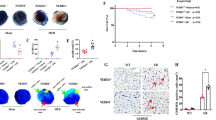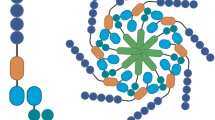Abstract
NLRP3 inflammasome is necessary for initiating acute sterile inflammation. Recent studies have demonstrated that NLRP3 inflammasome is up-regulated and mediates myocardial ischemia/reperfusion (MI/R) injury. However, the signaling pathways that lead to the activation of NLRP3 inflammasome by MI/R injury have not been fully elucidated. C57BL/6J mice were subjected to 30 min ischemia and 3 or 24 h reperfusion. The ischemic heart exhibited enhanced inflammasome activation as evidenced by increased NLRP3 expression and caspase-1 activity and increased IL-1β and IL-18 production. Intramyocardial NLRP3 siRNA injection or an intraperitoneal injection of BAY 11-7028, an inflammasome inhibitor, attenuated macrophage and neutrophil infiltration and decreased MI/R injury, as measured by cardiomyocyte apoptosis and infarct size. The ischemic heart also exhibited enhanced interaction between Txnip and NLRP3, which has been shown to be a mechanism for activating NLRP3. Intramyocardial Txnip siRNA injection also decreased infarct size and NLRP3 activation. In vitro experiments revealed that NLRP3 was expressed in cardiac microvascular endothelial cells (CMECs), but was hardly expressed in cardiomyocytes. Simulated ischemia/reperfusion (SI/R) stimulated NLRP3 inflammasome activation in CMECs, but not in cardiomyocytes. Moreover, CMECs subjected to SI/R injury increased interactions between Txnip and NLRP3. Txnip siRNA diminished NLRP3 inflammasome activation and SI/R-induced injury, as measured by LDH release and caspase-3 activity in CMECs. ROS scavenger dissociated TXNIP from NLRP3 and inhibited the activation of NLRP3 inflammasome in the CMECs. For the first time, we demonstrated that TXNIP-mediated NLRP3 inflammasome activation in CMECs was a novel mechanism of MI/R injury. Interventions that block Txnip/NLRP3 signaling to inhibit the activation of NLRP3 inflammasomes may be novel therapies for mitigating MI/R injury.







Similar content being viewed by others
References
Arslan F, Smeets MB, O’Neill LA, Keogh B, McGuirk P, Timmers L, Tersteeg C, Hoefer IE, Doevendans PA, Pasterkamp G, de Kleijn DP (2010) Myocardial ischemia/reperfusion injury is mediated by leukocytic toll-like receptor-2 and reduced by systemic administration of a novel anti-toll-like receptor-2 antibody. Circulation 121:80–90. doi:10.1161/CIRCULATIONAHA.109.880187
Baars T, Konorza T, Kahlert P, Mohlenkamp S, Erbel R, Heusch G, Kleinbongard P (2013) Coronary aspirate TNF alpha reflects saphenous vein bypass graft restenosis risk in diabetic patients. Cardiovasc Diabetol 12:12. doi:10.1186/1475-2840-12-12
Calvert JW, Gundewar S, Jha S, Greer JJ, Bestermann WH, Tian R, Lefer DJ (2008) Acute metformin therapy confers cardioprotection against myocardial infarction via AMPK-eNOS-mediated signaling. Diabetes 57:696–705
Cook-Mills JM, Deem TL (2005) Active participation of endothelial cells in inflammation. J Leukoc Biol 77:487–495
Danese S, Dejana E, Fiocchi C (2007) Immune regulation by microvascular endothelial cells: directing innate and adaptive immunity, coagulation, and inflammation. J Immunol 178:6017–6022
Danese S, Dejana E, Fiocchi C (2007) Immune regulation by microvascular endothelial cells: directing innate and adaptive immunity, coagulation, and inflammation. J Immunol 178:6017–6022
Dostert C, Petrilli V, Van Bruggen R, Steele C, Mossman BT, Tschopp J (2008) Innate immune activation through Nalp3 inflammasome sensing of asbestos and silica. Science 320:674–677. doi:10.1126/science.1156995
Gao E, Lei YH, Shang X, Huang ZM, Zuo L, Boucher M, Fan Q, Chuprun JK, Ma XL, Koch WJ (2010) A novel and efficient model of coronary artery ligation and myocardial infarction in the mouse. Circ Res 107:1445–1453. doi:10.1161/CIRCRESAHA.110.223925
Heidemann J, Domschke W, Kucharzik T, Maaser C (2006) Intestinal microvascular endothelium and innate immunity in inflammatory bowel disease: a second line of defense? Infect Immun 74:5425–5432
Heusch G, Kleinbongard P, Skyschally A (2013) Myocardial infarction and coronary microvascular obstruction: an intimate, but complicated relationship. Basic Res Cardiol 108:380. doi:10.1007/s00395-013-0380-y
Hoetzenecker K, Assinger A, Lichtenauer M, Mildner M, Schweiger T, Starlinger P, Jakab A, Berenyi E, Pavo N, Zimmermann M, Gabriel C, Plass C, Gyongyosi M, Volf I, Ankersmit HJ (2012) Secretome of apoptotic peripheral blood cells (APOSEC) attenuates microvascular obstruction in a porcine closed chest reperfused acute myocardial infarction model: role of platelet aggregation and vasodilation. Basic Res Cardiol 107:292. doi:10.1007/s00395-012-0292-2
Inohara N, Nunez G (2003) NODs: intracellular proteins involved in inflammation and apoptosis. Nat Rev Immunol 3:371–382
Iyer SS, Pulskens WP, Sadler JJ, Butter LM, Teske GJ, Ulland TK, Eisenbarth SC, Florquin S, Flavell RA, Leemans JC, Sutterwala FS (2009) Necrotic cells trigger a sterile inflammatory response through the Nlrp3 inflammasome. Proc Natl Acad Sci USA 106:20388–20393. doi:10.1073/pnas.0908698106
Jin C, Flavell RA (2010) Molecular mechanism of NLRP3 inflammasome activation. J Clin Immunol 30:628–631. doi:10.1007/s10875-010-9440-3
Jordan JE, Zhao ZQ, Vinten-Johansen J (1999) The role of neutrophils in myocardial ischemia-reperfusion injury. Cardiovasc Res 43:860–878
Kawaguchi M, Takahashi M, Hata T, Kashima Y, Usui F, Morimoto H, Izawa A, Takahashi Y, Masumoto J, Koyama J, Hongo M, Noda T, Nakayama J, Sagara J, Taniguchi S, Ikeda U (2011) Inflammasome activation of cardiac fibroblasts is essential for myocardial ischemia/reperfusion injury. Circulation 123:594–604. doi:10.1161/CIRCULATIONAHA.110.982777
Kleinbongard P, Bose D, Baars T, Mohlenkamp S, Konorza T, Schoner S, Elter-Schulz M, Eggebrecht H, Degen H, Haude M, Levkau B, Schulz R, Erbel R, Heusch G (2011) Vasoconstrictor potential of coronary aspirate from patients undergoing stenting of saphenous vein aortocoronary bypass grafts and its pharmacological attenuation. Circ Res 108:344–352. doi:10.1161/CIRCRESAHA.110.235713
Liu Y, Ma Y, Wang R, Xia C, Zhang R, Lian K, Luan R, Sun L, Yang L, Lau WB, Wang H, Tao L (2011) Advanced glycation end products accelerate ischemia/reperfusion injury through receptor of advanced end product/nitrative thioredoxin inactivation in cardiac microvascular endothelial cells. Antioxid Redox Signal 15:1769–1778. doi:10.1089/ars.2010.3764
Martinon F, Burns K, Tschopp J (2002) The inflammasome: a molecular platform triggering activation of inflammatory caspases and processing of proIL-beta. Mol Cell 10:417–426
Menu P, Vince JE (2011) The NLRP3 inflammasome in health and disease: the good, the bad and the ugly. Clin Exp Immunol 166:1–15. doi:10.1111/j.1365-2249.2011.04440.x
Mezzaroma E, Toldo S, Farkas D, Seropian IM, Van Tassell BW, Salloum FN, Kannan HR, Menna AC, Voelkel NF, Abbate A (2011) The inflammasome promotes adverse cardiac remodeling following acute myocardial infarction in the mouse. Proc Natl Acad Sci USA 108:19725–19730. doi:10.1073/pnas.1108586108
Nishida M, Carley WW, Gerritsen ME, Ellingsen O, Kelly RA, Smith TW (1993) Isolation and characterization of human and rat cardiac microvascular endothelial cells. Am J Physiol 264:H639–H652
Nishiyama A, Matsui M, Iwata S, Hirota K, Masutani H, Nakamura H, Takagi Y, Sono H, Gon Y, Yodoi J (1999) Identification of thioredoxin-binding protein-2/vitamin D(3) up-regulated protein 1 as a negative regulator of thioredoxin function and expression. J Biol Chem 274:21645–21650
Pober JS, Sessa WC (2007) Evolving functions of endothelial cells in inflammation. Nat Rev Immunol 7:803–815
Pomerantz BJ, Reznikov LL, Harken AH, Dinarello CA (2001) Inhibition of caspase 1 reduces human myocardial ischemic dysfunction via inhibition of IL-18 and IL-1beta. Proc Natl Acad Sci USA 98:2871–2876
Sandanger O, Ranheim T, Vinge LE, Bliksoen M, Alfsnes K, Finsen AV, Dahl CP, Askevold ET, Florholmen G, Christensen G, Fitzgerald KA, Lien E, Valen G, Espevik T, Aukrust P, Yndestad A (2013) The NLRP3 inflammasome is up-regulated in cardiac fibroblasts and mediates myocardial ischaemia-reperfusion injury. Cardiovasc Res 99:164–174. doi:10.1093/cvr/cvt091
Scarabelli T, Stephanou A, Rayment N, Pasini E, Comini L, Curello S, Ferrari R, Knight R, Latchman D (2001) Apoptosis of endothelial cells precedes myocyte cell apoptosis in ischemia/reperfusion injury. Circulation 104:253–256
Schroder K, Tschopp J (2010) The inflammasomes. Cell 140:821–832. doi:10.1016/j.cell.2010.01.040
Steffens S, Montecucco F, Mach F (2009) The inflammatory response as a target to reduce myocardial ischaemia and reperfusion injury. Thromb Haemost 102:240–247. doi:10.1160/TH08-12-0837
Stutz A, Golenbock DT, Latz E (2009) Inflammasomes: too big to miss. J Clin Invest 119:3502–3511. doi:10.1172/JCI40599
Tao L, Gao E, Bryan NS, Qu Y, Liu HR, Hu A, Christopher TA, Lopez BL, Yodoi J, Koch WJ, Feelisch M, Ma XL (2004) Cardioprotective effects of thioredoxin in myocardial ischemia and reperfusion: role of S-nitrosation [corrected]. Proc Natl Acad Sci USA 101:11471–11476
Tschopp J, Martinon F, Burns K (2003) NALPs: a novel protein family involved in inflammation. Nat Rev Mol Cell Biol 4:95–104
Wanderer AA (2008) Ischemic-reperfusion syndromes: biochemical and immunologic rationale for IL-1 targeted therapy. Clin Immunol 128:127–132. doi:10.1016/j.clim.2008.03.514
Wen H, Ting JP, O’Neill LA (2012) A role for the NLRP3 inflammasome in metabolic diseases–did warburg miss inflammation? Nat Immunol 13:352–357. doi:10.1038/ni.2228
Yang D, Guo S, Zhang T, Li H (2009) Hypothermia attenuates ischemia/reperfusion-induced endothelial cell apoptosis via alterations in apoptotic pathways and JNK signaling. FEBS Lett 583:2500–2506. doi:10.1016/j.febslet.2009.07.006
Yellon DM, Hausenloy DJ (2007) Myocardial reperfusion injury. N Engl J Med 357:1121–1135
Yin Y, Yan Y, Jiang X, Mai J, Chen NC, Wang H, Yang XF (2009) Inflammasomes are differentially expressed in cardiovascular and other tissues. Int J Immunopathol Pharmacol 22:311–322
Yoshioka J, Chutkow WA, Lee S, Kim JB, Yan J, Tian R, Lindsey ML, Feener EP, Seidman CE, Seidman JG, Lee RT (2012) Deletion of thioredoxin-interacting protein in mice impairs mitochondrial function but protects the myocardium from ischemia-reperfusion injury. J Clin Invest 122:267–279. doi:10.1172/JCI44927
Zhou R, Tardivel A, Thorens B, Choi I, Tschopp J (2010) Thioredoxin-interacting protein links oxidative stress to inflammasome activation. Nat Immunol 11:136–140. doi:10.1038/ni.1831
Acknowledgments
This work was supported by program for Chinese National Science Fund for Distinguished Young Scholars (Grant No. 81225001), National Key Basic Research Program of China (973 Program, 2013CB531204), New Century Excellent Talents in University (Grant No. NCET-11-0870), Chinese National Science Funds (Grants Nos. 81070676 and 81170186), Innovation Team Development Grant by China Department of Education (2010CXTD01) and Major Science and Technology Projects of China “Significant New Drug Development” (Grant No. 2012ZX09J12108-06B).
Conflict of interest
The authors declare that no conflict of interest exists.
Author information
Authors and Affiliations
Corresponding authors
Additional information
Y. Liu, K. Lian and L. Zhang contributed equally to this work.
Electronic supplementary material
Below is the link to the electronic supplementary material.
395_2014_415_MOESM1_ESM.tif
Supplement Fig1 NLRP3 siRNA had no effect on the expression of Txnip in CMECs. CMECs were transfected with NLRP3 siRNA for 48 hours, and Txnip expression was determined using Western blots (n = 5 per group). Data were expressed as mean ± SEM (TIFF 324 kb)
395_2014_415_MOESM2_ESM.tif
Supplement Fig 2 NLRP3 siRNA decreased the E-selectin and ICAM-1 expression in CMECs subjected to SI/R. CMECs were transfected with NLRP3 siRNA for 48 hours and then subjected to SI/R. E-selectin (A) and ICAM-1 (B) expression express was determined by western-blot (n = 5 per group). Data were expressed as mean ± SEM. *P<0.05 vs. Sham group; # P<0.05 vs. Vehicle (TIFF 1,627 kb)
395_2014_415_MOESM3_ESM.tif
Supplement Fig3 Txnip overexpression exacerbated NLRP3 inflammasome activation and SI/R injury in CMECs. A) CMECs were transfected with Txnip-GFP for 24 hours, and Txnip expression was determined using Western blots (n = 5 per group). B) CMECs were transfected with Txnip-GFP for 24 hours and then were subjected to SI/R injury followed by 24 hours of LPS treatment, and then were subjected to SI/R injury. IL-1β content was determined using ELISA (n = 6 per group).C and D) CMECs were treated with Txnip-GFP for 24 hours and then subjected to SI/R injury. LDH release and caspase-3 activity were determined using enzyme activity assay kit (n = 6 per group). Data were expressed as mean ± SEM. $$ P<0.01 vs. Control group, *P<0.05, **P<0.01 vs. Sham group; # P<0.05 vs. Vehicle group (TIFF 3,671 kb)
Rights and permissions
About this article
Cite this article
Liu, Y., Lian, K., Zhang, L. et al. TXNIP mediates NLRP3 inflammasome activation in cardiac microvascular endothelial cells as a novel mechanism in myocardial ischemia/reperfusion injury. Basic Res Cardiol 109, 415 (2014). https://doi.org/10.1007/s00395-014-0415-z
Received:
Revised:
Accepted:
Published:
DOI: https://doi.org/10.1007/s00395-014-0415-z




